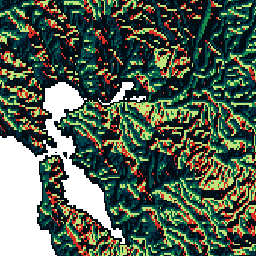Page Summary
-
The HydroSHEDS drainage direction dataset defines the direction of flow from each cell to its steepest down-slope neighbor, with specific values indicating direction or outlet/sink locations.
-
This dataset, based on 2000 SRTM elevation data, is available at a 30 arc-second resolution for Hydrologically Conditioned DEM, Drainage Direction, and Flow Accumulation.
-
HydroSHEDS data is free for both non-commercial and commercial use according to its License Agreement.

- Dataset Availability
- 2000-02-11T00:00:00Z–2000-02-22T00:00:00Z
- Dataset Provider
- WWF
- Tags
Description
HydroSHEDS is a mapping product that provides hydrographic information for regional and global-scale applications in a consistent format. It offers a suite of geo-referenced datasets (vector and raster) at various scales, including river networks, watershed boundaries, drainage directions, and flow accumulations. HydroSHEDS is based on elevation data obtained in 2000 by NASA's Shuttle Radar Topography Mission (SRTM).
This drainage direction dataset defines the direction
of flow from each cell in the conditioned DEM to its steepest
down-slope neighbor. Values of drainage direction vary from 1
to 128. All final outlet cells to the ocean are flagged with
a value of 0. All cells that mark the lowest point of an endorheic
basin (inland sink) are flagged with a value of -1. The drainage
direction values follow the convention adopted by ESRI's flow
direction implementation: 1=E, 2=SE, 4=S, 8=SW, 16=W, 32=NW,
64=N, 128=NE.
This dataset is at 30 arc-second resolution.
The datasets available at 30 arc-seconds are the Hydrologically
Conditioned DEM, Drainage (Flow) Direction, and Flow Accumulation.
Note that the quality of the HydroSHEDS data is significantly lower for regions above 60 degrees northern latitude as there is no underlying SRTM elevation data available and thus a coarser-resolution DEM was (HYDRO1k provided by USGS).
HydroSHEDS was developed by the World Wildlife Fund (WWF) Conservation Science Program in partnership with the U.S. Geological Survey, the International Centre for Tropical Agriculture, The Nature Conservancy, and the Center for Environmental Systems Research of the University of Kassel, Germany.
Bands
Pixel Size
927.67 meters
Bands
| Name | Min | Max | Pixel Size | Description |
|---|---|---|---|---|
b1 |
0* | 255* | meters | Drainage direction possible values: 1=E, 2=SE, 4=S, 8=SW, 16=W, 32=NW, 64=N, 128=NE; final outlet cells to the ocean are flagged with a value of 0 and cells that mark the lowest point of an endorheic basin (inland sink) are flagged with a value of 255 (original value of -1) |
Terms of Use
Terms of Use
HydroSHEDS data are free for non-commercial and commercial use. For more information, please refer to the License Agreement.
Citations
Lehner, B., Verdin, K., Jarvis, A. (2008): New global hydrography derived from spaceborne elevation data. Eos, Transactions, AGU, 89(10): 93-94.
Explore with Earth Engine
Code Editor (JavaScript)
var dataset = ee.Image('WWF/HydroSHEDS/30DIR'); var drainageDirection = dataset.select('b1'); var drainageDirectionVis = { min: 1.0, max: 128.0, palette: [ '000000', '023858', '006837', '1a9850', '66bd63', 'a6d96a', 'd9ef8b', 'ffffbf', 'fee08b', 'fdae61', 'f46d43', 'd73027' ], }; Map.setCenter(-121.652, 38.022, 8); Map.addLayer(drainageDirection, drainageDirectionVis, 'Drainage Direction');